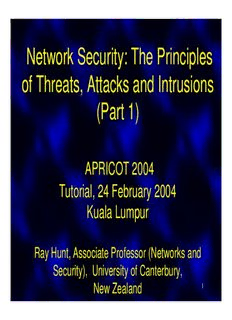
File 2 - apricot PDF
Preview File 2 - apricot
Network Security: The Principles of Threats, Attacks and Intrusions (Part 1) APRICOT 2004 Tutorial, 24 February 2004 Kuala Lumpur Ray Hunt, Associate Professor (Networks and Security), University of Canterbury, New Zealand 1 2 Contents (cid:1) Background to security risks and the Internet (cid:1) TCP/IP vulnerabilities (cid:1) Attack Trends (cid:1) Classification of attacks (cid:1) Social Engineering (cid:1) Hacking or Cracking (cid:1) Viruses and Worms Blended Attacks (cid:1) Trojan Horses (cid:1) Network Layer Attacks - spoofing, hijacking (cid:1) (Distributed) Denial of Service Attacks Live tests reported in “Cryptogram” (B. Schneier) www.counterpane.com • A random computer on the Internet is scanned dozens of times a day • The life expectancy of a default installation of Red Hat 6.2 server, or the time before someone successfully hacks it, is less than 72 hours • A Windows home user with file sharing enabled, was hacked five times in four days • Systems are subjected to NetBIOS scans an average of 17 times a day • The fastest time for a server being hacked: 15 minutes after plugging it into the network 4 Quote from Kevin Mitnick …. (cid:1) “It's naive to assume that just installing a firewall is going to protect you from all potential security threats. That assumption creates a false sense of security which can be worse than having no security at all.'’ 5 Security and the Internet …... (cid:1) Between February 2000 and December 2001 we have seen…. (cid:1) The biggest Denial of Service Attack in the history of computing (7-11 February 2000) (cid:1) The biggest Virus Attack in the history of computing (“I Love You”, 4 May 2000) (cid:1) The biggest Worm Attack in the history of computing (Nimda, 18 Sept 2001) 6 Security and the Internet …... (cid:1) Lion Worm Ver 0.11 released March 29, 2001 (cid:1) Release of the Code-Red Worm July 19, 2001 (cid:1) Infected 359,000 computers in 14 hours (cid:1) At peak 2000 computers were being infected per minute (cid:1) Release of Nimda Worm on 18 September 2001 (cid:1) Infected 160,000 at peak (cid:1) within one day 450,000 unique IP addresses were attempting to spread the worm (cid:1) …. Leading to some of the most dangerous web server attacks ever known (18 September 2001) 7 Significant Vulnerabilities in 2002 (cid:1) Gigger Worm - JavaScript virus attacks Microsoft Outlook, Microsoft Express and IRC (cid:1) Buffer overflow problems with Internet Explorer 5.01, 5.5 and 6.0 and IIS 4.5 and 5.1 (cid:1) DOS problems in Microsoft’s IIS 4.0, 5.0, 5.1, Cisco’s ADSL routers, SNMPv1, and DNS Bind v9 Providing you are not using Microsoft Outlook, Microsoft Express, Internet Explorer, IRC, SNMP Network Management, DNS Bind or any of Microsoft’s web servers since IIS 4.0 - you should be OK!! Significant Vulnerabilities in 2003 (cid:1) 25 January, 2003 - SQL Server (Slammer) Worm (cid:1) Small MS SQL Worm (376 bytes) replicates itself using a buffer overflow technique. (cid:1) When worm gains control it generates random IP Address and send itself by connecting to remote UDP port 1434 (cid:1) Large number of attempts leads to Denial of Service attack (cid:1) www.ravantivirus.com/virus/showvirus.php?v=164 (cid:1) www.cert.org/advisories/CA-2003-04.html 9 Significant Vulnerabilities in 2003 (cid:1) 16 July, 2003 - Buffer Overflow in Windows RPC and XP Shell - Severity Rating: High (cid:1) RPC Buffer overflow in RPC allows attacker to gain absolute control of a Windows machine!! (cid:1) XP Buffer overflow allows attacker to execute code with logged-in user’s privlidges!! (cid:1) Both of these are severe and a rating of “high” has not been seen for over a year (cid:1) www.watchguard.com/archive/images/lsglossary.htm#rpc 10
Description: